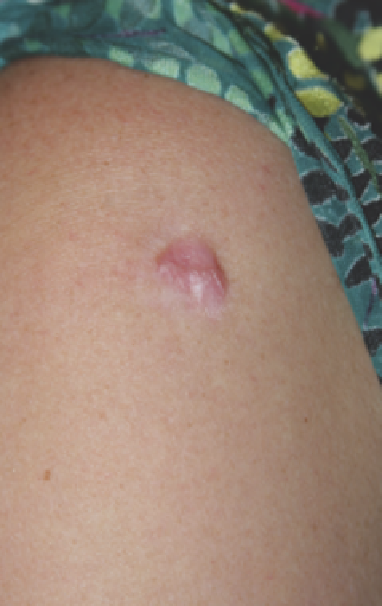Biomedical Engineering Reference
In-Depth Information
Goldan et al. (214) reported successful treatment of hypertro-
phic scars occurring after facial dermabrasion in a 67-year-old
woman. The scars were very painful and pruritic and involved
the nasolabial folds and chin. Treatment with IL steroids was not
successful. She received six treatments of IL 5-FU (50 mg/cc) at
2-week intervals. There was marked improvement in size, color,
and texture of the scars as well as total elimination of her symp-
toms of pain and itching. Seven months after treatment all scars
remained stable.
Mutalik and Patwardhan (215) reported a series of 24 patients
with keloids that were treated with IL 5-FU (50 mg/cc) at
4-week intervals. Sixteen patients (67%) showed complete fl at-
tening of their keloids after an average of four treatment ses-
sions. Twelve of these patients (75%) had no recurrence after
1 year. Some patients also had additional injections of triamcin-
olone 40 mg/cc, but no further information is provided except
that two patients developed post-steroid hypopigmentation.
A prospective study of treatment of keloids and hyper-
trophic scars with IL 5-FU following excision of keloids and
hypertrophic scars without excision revealed a 19% recurrence
rate of keloids and a 50% median decrease in scar volume in
hypertrophic scars (216).
Haurani et al. (205) performed a prospective case series study
of 32 patients with keloids and 21 patients with hypertrophic
scars, all of whom had failed to respond to IL steroid therapy.
Those with keloids were treated with excision followed 2 weeks
later with IL 5-FU (50 mg/cc). This was repeated at monthly
intervals for 10 treatments with a follow-up of 1 year after the
10th treatment. Hypertrophic scars were treated with IL 5-FU
(50 mg/cc) at monthly intervals without excision. A maximum
dose of 50 mg per treatment was used. In the keloid group, the
measured volume of the lesion after excision remained stable
with only a 0.06 cm
3
increase in volume at the 1-year follow-up.
Six patients were noted to have recurrence of scar growth
(19%). In addition, 90% of patients had partial or complete
relief of symptoms of pruritus or pain. In the hypertrophic scar
group 86% had improvement in symptoms and a 40% reduc-
tion in scar volume after the 1-year follow-up.
A double-blind randomized clinical study of 50 patients with
keloids (2-6 cm in size and 2-5 years in duration) involved two
groups of 25 patients. In each group, keloids were excised,
followed by application of silicon sheets for 6-12 months. The
study group also received IL 5-FU (50 mg/cc) at days 7, 14, and
28 and at 2 and 3 months postoperatively. At 1 year, the study
group showed 18 (75%) were keloid free and fi ve (21%) had
improvement in size, thickness, and texture. In the control
group, 10 (43%) were keloid free, 8 (35%) had improvement,
and 7 (22%) failed to respond (217).
Katz et al. (218) report a successful treatment of perioral
scarring following phenol peel in a 75-year-old woman, using
595-nm PDL, 1450-nm diode laser in combination with 5-FU
(45 mg/cc), and triamcinolone (0.1 cc of Kenalog 10 mg/cc)
mixed in the same syringe. Treatments were performed at 1- to
2-month intervals with a total of 10 treatments over 1 year.
After 1 month, greater than 25% improvement was noted;
after fi ve treatments, 90% improvement was noted; and after
2.5 years, the noted improvement persisted.
In a review of medical evidence levels A, B, and C, Gupta and
Sharma (219) conclude that IL 5-FU is considered a safe and
effective treatment of keloids and hypertrophic scars when
used alone or in combination with IL steroids and surgical
excision (Figs. 9.21 and 9.22).
(
A
)
(
B
)
Figure 9.21
(
A
) Hypertrophic scar of deltoid area. (
B
) Flattening of scar is seen after treatment with intralesional 5-FU (45 mg/cc) and triamcinolone (1 mg/cc)
performed at 1- to 4-week intervals. Average volume injected was 0.2 cc and there were a total of 10 treatment sessions.

















